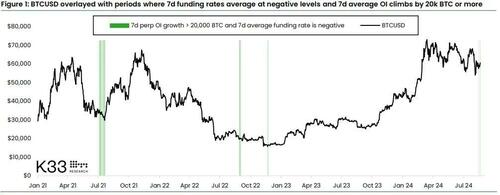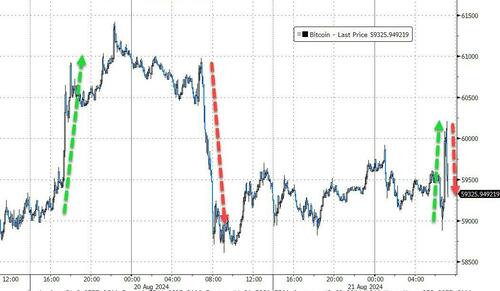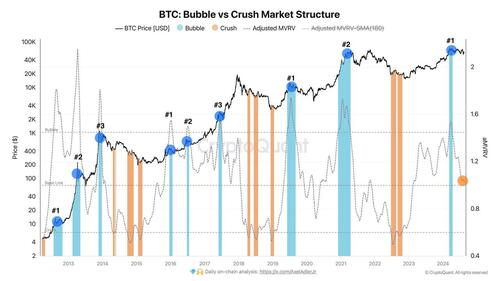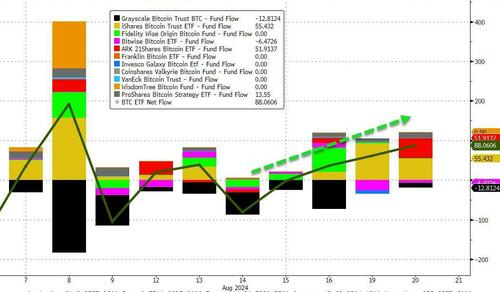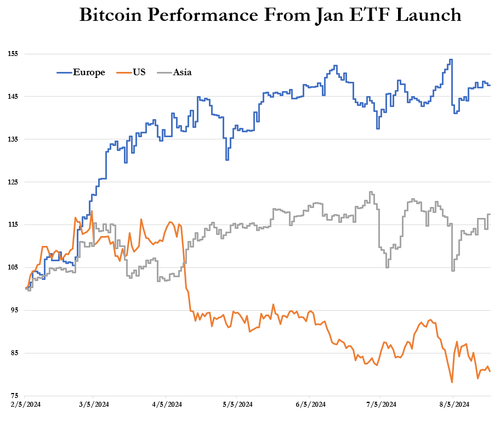Surge In Derivative Bets Leaves Bitcoin "Ripe For A Short Squeeze" As ETF Inflows Accelerate
Traders aggressively betting on further moves south for Bitcoin could be caught unawares in the coming days and weeks, with the derivatives market forming a setup primed for a short squeeze.
That’s according to research-led digital assets brokerage K33’s latest analysis, which found a mix of both negative perpetual swap funding rates in recent weeks and a spike in open interest.
“This suggests aggressive shorting, structurally creating a setup ripe for a short squeeze,” K33 analyst Vetle Lunde wrote in a note to investors on Tuesday.
As Decrypt reports, K33's call for a short squeeze hinges on the 7-day average funding rate, which has decreased since the market crash on August 5, hitting -2.53% on Tuesday.
That’s the lowest it’s been since March 2023, Lunde wrote.
Meanwhile, notional open interest over the last seven days has jumped to its most significant weekly recording in over a year, above 28,880 BTC.
“The current combination of surging open interest and negative 7-day average funding rates is unique and promising,” Lunde wrote.
As a reminder, Decrypt explains that funding rates are periodic payments made between traders in futures markets, specifically for perpetual contracts, which are a type of futures contract without an expiration date.
The rates are used to keep the price of the perpetual contract in line with the spot price.
When the funding rate is positive, more traders betting on prices going up (long positions) pay a fee to those betting on prices going down (short positions).
When the funding rate is negative, it reflects a larger number of traders betting on prices going down are paying a sizeable fee to those banking on prices going up.
Typically, when things are steady, the rate hovers around 10.95%, Lunde wrote.
But when many people start betting aggressively, the rate can move from what’s expected, which normally shows more traders are piling into the same bet.
Bitcoin prices have been significantly choppy in recent days as the short-interest has built (and obviously today's payrolls revisions has all the algos on edge)...
And as we noted recently it's not just bitcoin that is seeing its share of negativity...
someone is desperate to slam ETH lower https://t.co/bovdhybpbZ
— zerohedge (@zerohedge) August 11, 2024
Building on that potential, CoinTelegraph reports that several of Bitcoin’s popular trading metrics are flashing positive which may force traders to act quickly and cover their positions if macroeconomic events align, according to a crypto analyst.
“Technical indicators are improving, and with some traders holding short positions, there’s potential for a short squeeze,” 10x Research head of research Markus Thielen said in an Aug. 21 report.
In an Aug. 18 report, CryptoQuant researcher Axel Adler looked to two key metrics - the bubble vs. crush market structure and the ratio between the difference of market cap and realized cap and the standard deviation of market cap (MVRV-Z score) - as signals that Bitcoin’s current price action is tracking a healthy path forward.
“We can see that the current bull cycle is developing quite steadily without significant anomalies or sharp jumps,” Adler added.
Adding to the bullish sentiment, US spot Bitcoin ETFs have maintained positive flows for eight out of the past ten consecutive trading days. On Aug. 20, the ETFs saw an aggregate inflow of $88 million, their highest for two weeks...
IBIT, which surpassed longtime Bitcoin ETF player Grayscale in terms of assets under management (AUM), has not seen an outflow day since May 1 - the only day of net outflows it has had since it launched in January.
It was also recently reported that 60% of the largest hedge funds in the United States have exposure to Bitcoin ETFs, according to Sam Baker, researcher at investment firm River.
Finally, we note a clear pattern emerging in intraday bitcoin trading since spot ETFs were introduced.
As we have noted numerous times, it appears the perpetual futures market dominates the US session (to the downside), which then enables the ETFs to buy at lower prices during the following Asia and European sessions.
Trade accordingly...


